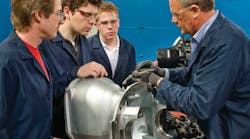Most of us know that small businesses are the backbone of the U.S. economy and the largest total employer in our country. A lot has been written on the ensured longevity of individual small businesses, usually centered on the topic of succession planning, in one form or another. To be sure, this is a worthwhile area on which to keep the dialogue open and moving.
While some business owners viewing retirement are fortunate to have family members or long-time, loyal employees to develop and integrate into ownership, others simply look for a buyer for their business. Either one of these ways will work, but both can have differing results.
Common Successful Strategies
I have been fortunate to have worked in this industry for my entire career. Much of that time has been spent selling to or working with family-owned businesses - both large and small.
In my observations, the ones that make it through several successive generations share a couple of processes and business strategies. One is that the owner/top management makes all hiring decisions and is constantly grooming and training great talent to become the future of the company.
This common thread is very apparent when you watch the constant development and upward movement of the new/next generation of employees and involved family members.
You can look at the succeeding generation's actions and quickly determine if they are progressively advancing the business or simply managing its decline to its demise or sale.
Another shared strategy is that owner/top management are continuously working on their own knowledge base to stay abreast or ahead of today's hyper-competitive business environment. They do this through a number ways, including listening to the new generation's thoughts and ideas, and placing a high value on the investment they have made in those individuals.
20 Groups
Owner/top management also do peer-networking (even with competitors) and constantly monitor the state of their industry, often through participation in 20 Groups. These are where business people - both in and out of an industry - meet and discuss ideas and techniques for success.
The true progressive leaders seem to gravitate toward 20 Groups. Owners/top management that hide in their business while the world and their market are constantly changing around them will ensure a decline and could result in business failure.
My own association currently runs six 20 Groups for our members. In such gatherings, the 20 Group members, typically executives in our organization, are continuously exposed to what their peers and even competitors are doing to advance and succeed as enterprises.
A Group Solution
My own association, HDMA, currently runs six executive forums for our members. In such gatherings, the group members are continuously exposed to what their peers and even competitors are doing to advance and succeed as enterprises.
Through one of these executive forums, we had an opportunity to see what a very progressive 20 Group of manufacturers was doing in their market on the toughest challenge for any size firm: identifying and hiring top entry-level people that are best suited for current and future positions. They realized that the talent pool for their needs would be a major bottleneck, particularly given the number of major Fortune 100 employers in their market area.
All members of this 20 Group had open positions and/or sufficient turnover to predict how many of the varied types of individuals would be needed for their current and future requirements. The needs ranged from material handlers, to engineers, to future management and executives.
The solution they came up with was to work as a group with the local high schools, community colleges and universities to help with curriculum suggestions and offer plant and office tours for instructors and select students and administrators.
The educators were very impressed, as many of them had not spent much time looking at the real-world environment in the private sector. They saw the range of opportunities for the several levels of student they were teaching.
In addition, through considerable research, this 20 Group was able to look at the available pool of current high school seniors, community college and university students.
A Revealing Process
This manufacturer's group developed an impressive process of exposing selected students - potential employees - to actual work, while at the same time being able to take a good look at the candidates for future positions. Selected high school seniors and community college and university students usually in their junior year are given a chance to work as summer interns in the companies in various positions.
After evaluation of their tenure as an intern, many of these students are invited to interview and then participate in what the companies call a test drive. This consists of a salary for working several weeks up to a three-month period in increasingly challenging assignments in the company. During this time, the candidates are evaluated by the company for their potential, ability, drive and possible fit within the company's cultural environment.
At the end of the test drive, the companies decide whether or not to offer a permanent position to the individuals.
After a few years of working this plan, the participating business owners have seen great success with hiring the best of the best and their results are showing it. These individuals are some of the highest productivity employees and their turnover is very low.
I would suggest you consider using this strategy when doing your own succession planning. It has been one of the most innovative approaches I have seen.




